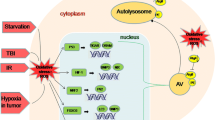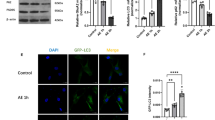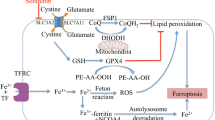Abstract
Arecoline is a major alkaloid of areca nut and has been effect on central nervous system. Although arecoline-induced neurotoxicity has been reported, the possible underlying neurotoxic mechanisms have not yet been elucidated. Increasing evidences have shown that both excessive endoplasmic reticulum (ER) stress and disturbance of hydrogen sulfide (H2S) production are involved in the pathophysiology of numerous neurodegenerative diseases. Here, the purpose of present study was to verify whether ER stress and the disturbance of endogenous H2S generation are also involved in arecoline-caused neurotoxicity. We found that treatment of PC12 cells with arecoline induced the down-regulation of cells viability and up-regulation of apoptosis and the activity of caspase-3, indicating the neurotoxic role of arecoline to PC12 cells. In addition, arecoline also increased the expression of Bax (pro-apoptotic protein) and attenuated the expression of Bcl-2 (anti-apoptotic protein) in PC12 cells. Simultaneously, arecoline caused excessive ER stress in PC12 cells, as evidenced by the up-regulations of Glucose-regulated protein 78 (GRP78), CCAAT/enhancer binding protein homologous protein (CHOP), and Cleaved caspase-12 expressions. Notably, the level of H2S in the culture supernatant and the expressions of cystathionine β-synthase and 3-mercaptopyruvate sulfurtransferase (two major enzymes for endogenous H2S generation in PC12 cells) were also reduced by arecoline treatment. These results indicate that arecoline-caused neurotoxicity to PC12 cells is involved in ER stress and disturbance of endogenous H2S generation and suggest that the modulation of ER stress and endogenous H2S generation may be potential therapeutic approach in treatment of arecoline-caused neurotoxicity.





Similar content being viewed by others
References
Garg A, Chaturvedi P, Gupta PC (2014) A review of the systemic adverse effects of areca nut or betel nut. Indian J Med Paediatr Oncol: Off J Indian Soc Med Paediatr Oncol 35:3–9
Dasgupta R, Saha I, Pal S, Bhattacharyya A, Sa G, Nag TC, Das T, Maiti BR (2006) Immunosuppression, hepatotoxicity and depression of antioxidant status by arecoline in albino mice. Toxicology 227:94–104
Khan S, Chatra L, Prashanth SK, Veena KM, Rao PK (2012) Pathogenesis of oral submucous fibrosis. J Cancer Res Ther 8:199–203
Choudhury MD, Chetia P, Choudhury KD, Talukdar AD, Datta-Choudhari M (2012) Atherogenic effect of arecoline: a computational study. Bioinformation 8:229–232
Thangjam GS, Kondaiah P (2009) Regulation of oxidative-stress responsive genes by arecoline in human keratinocytes. J Periodontal Res 44:673–682
Hung KF, Lai KC, Liu TY, Liu CJ, Lee TC, Lo JF (2009) Asb6 upregulation by Areca nut extracts is associated with betel quid-induced oral carcinogenesis. Oral Oncol 45:543–548
Sadashiva CT, Chandra JN, Kavitha CV, Thimmegowda A, Subhash MN, Rangappa KS (2009) Synthesis and pharmacological evaluation of novel N-alkyl/aryl substituted thiazolidinone arecoline analogues as muscarinic receptor 1 agonist in Alzheimer’s dementia models. Eur J Med Chem 44:4848–4854
Bales A, Peterson MJ, Ojha S, Upadhaya K, Adhikari B, Barrett B (2009) Associations between betel nut (Areca catechu) and symptoms of schizophrenia among patients in Nepal: a longitudinal study. Psychiatry Res 169:203–211
Monmaur P, Allix M, Schoevaert-Brossault D, Houcine O, Plotkine M, Willig F (1990) Effects of transient cerebral ischemia on the hippocampal dentate theta (theta) profile in the acute rat: a study 4–5 months following recirculation. Brain Res 508:124–134
Shih YT, Chen PS, Wu CH, Tseng YT, Wu YC, Lo YC (2010) Arecoline, a major alkaloid of the areca nut, causes neurotoxicity through enhancement of oxidative stress and suppression of the antioxidant protective system. Free Radic Biol Med 49:1471–1479
Gething MJ, Sambrook J (1992) Protein folding in the cell. Nature 355:33–45
Ma Y, Hendershot LM (2004) ER chaperone functions during normal and stress conditions. J Chem Neuroanat 28:51–65
Placido AI, Pereira CM, Duarte AI, Candeias E, Correia SC, Carvalho C, Cardoso S, Oliveira CR, Moreira PI (2015) Modulation of endoplasmic reticulum stress: an opportunity to prevent neurodegeneration? CNS Neurol Disord: Drug Targets 14:518–533
Torres M, Matamala JM, Duran-Aniotz C, Cornejo VH, Foley A, Hetz C (2015) ER stress signaling and neurodegeneration: at the intersection between Alzheimer’s disease and prion-related disorders. Virus Res 207:69–75
Chaudhari N, Talwar P, Parimisetty A, Lefebvre d’Hellencourt C, Ravanan P (2014) A molecular web: endoplasmic reticulum stress, inflammation, and oxidative stress. Front Cell Neurosci 8:213
Fung TS, Liu DX (2014) Coronavirus infection, ER stress, apoptosis and innate immunity. Front Microbiol 5:296
Jin ML, Park SY, Kim YH, Oh JI, Lee SJ, Park G (2014) The neuroprotective effects of cordycepin inhibit glutamate-induced oxidative and ER stress-associated apoptosis in hippocampal HT22 cells. Neurotoxicology 41:102–111
Goswami P, Gupta S, Biswas J, Sharma S, Singh S (2015) Endoplasmic reticulum stress instigates the rotenone induced oxidative apoptotic neuronal death: a study in rat brain. Mol Neurobiol. doi:10.1007/s12035-015-9463-0
Wu CX, Liu R, Gao M, Zhao G, Wu S, Wu CF, Du GH (2013) Pinocembrin protects brain against ischemia/reperfusion injury by attenuating endoplasmic reticulum stress induced apoptosis. Neurosci Lett 546:57–62
Kim I, Xu W, Reed JC (2008) Cell death and endoplasmic reticulum stress: disease relevance and therapeutic opportunities. Nat Rev Drug Discov 7:1013–1030
Zhang X, Bian JS (2014) Hydrogen sulfide: a neuromodulator and neuroprotectant in the central nervous system. ACS Chem Neurosci 5:876–883
Abe K, Kimura H (1996) The possible role of hydrogen sulfide as an endogenous neuromodulator. J Neurosci 16:1066–1071
Zhang Q, Yuan L, Liu D, Wang J, Wang S, Zhang Q, Gong Y, Liu H, Hao A, Wang Z (2014) Hydrogen sulfide attenuates hypoxia-induced neurotoxicity through inhibiting microglial activation. Pharmacol Res 84:32–44
Li MH, Tang JP, Zhang P, Li X, Wang CY, Wei HJ, Yang XF, Zou W, Tang XQ (2014) Disturbance of endogenous hydrogen sulfide generation and endoplasmic reticulum stress in hippocampus are involved in homocysteine-induced defect in learning and memory of rats. Behav Brain Res 262:35–41
Nie L, Hu Y, Yan X, Li M, Chen L, Li H, Li X, Zhou H, Zheng Y (2013) The anti-apoptotic effect of hydrogen sulfide attenuates injuries to the medullary respiratory centers of neonatal rats subjected to in utero cigarette smoke exposure. Respir Physiol Neurobiol 188:29–38
Dwyer BE, Raina AK, Perry G, Smith MA (2004) Homocysteine and Alzheimer’s disease: a modifiable risk? Free Radic Biol Med 36:1471–1475
Du C, Jin M, Hong Y, Li Q, Wang XH, Xu JM, Wang F, Zhang Y, Jia J, Liu CF, Hu LF (2014) Downregulation of cystathionine beta-synthase/hydrogen sulfide contributes to rotenone-induced microglia polarization toward M1 type. Biochem Biophys Res Commun 451:239–245
Tang XQ, Fang HR, Zhou CF, Zhuang YY, Zhang P, Gu HF, Hu B (2013) A novel mechanism of formaldehyde neurotoxicity: inhibition of hydrogen sulfide generation by promoting overproduction of nitric oxide. PLoS ONE 8:e54829
Doeller JE, Isbell TS, Benavides G, Koenitzer J, Patel H, Patel RP, Lancaster JR Jr, Darley-Usmar VM, Kraus DW (2005) Polarographic measurement of hydrogen sulfide production and consumption by mammalian tissues. Anal Biochem 341:40–51
Cohen GM (1997) Caspases: the executioners of apoptosis. Biochem J 326(Pt 1):1–16
Logue SE, Cleary P, Saveljeva S, Samali A (2013) New directions in ER stress-induced cell death. Apoptosis 18:537–546
Hetz C (2012) The unfolded protein response: controlling cell fate decisions under ER stress and beyond. Nat Rev Mol Cell Biol 13:89–102
Zhou CF, Tang XQ (2011) Hydrogen sulfide and nervous system regulation. Chin Med J 124:3576–3582
Kimura H (2013) Physiological role of hydrogen sulfide and polysulfide in the central nervous system. Neurochem Int 63:492–497
Winstock A (2002) Areca nut-abuse liability, dependence and public health. Addict Biol 7:133–138
Li M, Gao F, Zhou ZS, Zhang HM, Zhang R, Wu YF, Bai MH, Li JJ, Lin SR, Peng JY (2014) Arecoline inhibits epithelial cell viability by upregulating the apoptosis pathway: implication for oral submucous fibrosis. Oncol Rep 31:2422–2428
Radi E, Formichi P, Battisti C, Federico A (2014) Apoptosis and oxidative stress in neurodegenerative diseases. J Alzheimer’s Dis 42(Suppl 3):S125–S152
Fadeel B, Ottosson A, Pervaiz S (2008) Big wheel keeps on turning: apoptosome regulation and its role in chemoresistance. Cell Death Differ 15:443–452
Cheng HL, Su SJ, Huang LW, Hsieh BS, Hu YC, Hung TC, Chang KL (2010) Arecoline induces HA22T/VGH hepatoma cells to undergo anoikis-involvement of STAT3 and RhoA activation. Mol Cancer 9:126
Stefani IC, Wright D, Polizzi KM, Kontoravdi C (2012) The role of ER stress-induced apoptosis in neurodegeneration. Curr Alzheimer Res 9:373–387
Luo Y, Yang X, Zhao S, Wei C, Yin Y, Liu T, Jiang S, Xie J, Wan X, Mao M, Wu J (2013) Hydrogen sulfide prevents OGD/R-induced apoptosis via improving mitochondrial dysfunction and suppressing an ROS-mediated caspase-3 pathway in cortical neurons. Neurochem Int 63:826–831
Yin J, Tu C, Zhao J, Ou D, Chen G, Liu Y, Xiao X (2013) Exogenous hydrogen sulfide protects against global cerebral ischemia/reperfusion injury via its anti-oxidative, anti-inflammatory and anti-apoptotic effects in rats. Brain Res 1491:188–196
Eto K, Asada T, Arima K, Makifuchi T, Kimura H (2002) Brain hydrogen sulfide is severely decreased in Alzheimer’s disease. Biochem Biophys Res Commun 293:1485–1488
Tan H, Zou W, Jiang J, Tian Y, Xiao Z, Bi L, Zeng H, Tang X (2015) Disturbance of hippocampal H2S generation contributes to CUMS-induced depression-like behavior: involvement in endoplasmic reticulum stress of hippocampus. Acta Biochim et Biophys Sin 47:285–291
Lin F, Chen Y, Liao C, Sun Y, Bai Y, Liao Y, Li M, Qi Y (2015) Hydrogen sulfide attenuates bronchial epithelial cell apoptosis by inhibiting endoplasmic reticulum stress. Zhonghua yi xue za zhi 95:2297–2301
Ying R, Wang XQ, Yang Y, Gu ZJ, Mai JT, Qiu Q, Chen YX, Wang JF (2016) Hydrogen sulfide suppresses endoplasmic reticulum stress-induced endothelial-to-mesenchymal transition through Src pathway. Life Sci 144:208–217
Acknowledgments
This study was supported by Natural Science Foundation of China (81202518), Zheng xiang Scholar Program of University of South China (2014-004), the construct program of the key discipline in Hunan province.
Author information
Authors and Affiliations
Corresponding authors
Additional information
Jia-Mei Jiang and Li Wang contributed equally to this work.
Rights and permissions
About this article
Cite this article
Jiang, JM., Wang, L., Gu, HF. et al. Arecoline Induces Neurotoxicity to PC12 Cells: Involvement in ER Stress and Disturbance of Endogenous H2S Generation. Neurochem Res 41, 2140–2148 (2016). https://doi.org/10.1007/s11064-016-1929-6
Received:
Revised:
Accepted:
Published:
Issue Date:
DOI: https://doi.org/10.1007/s11064-016-1929-6




